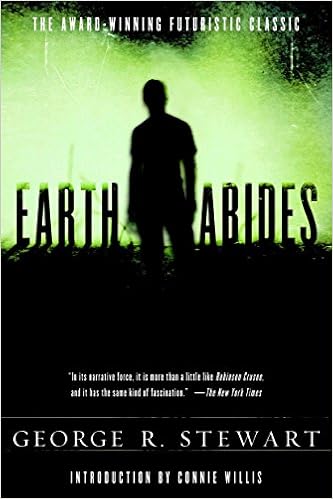Written in 1949,
Earth Abides is a post-apocalyptic novel that explores what happens to civilization as we know it when a viral pandemic wipes out the vast majority of people. Isherwood "Ish" Williams, a solitary graduate student with an interest in ecology and in studying the relationship between man and nature, is one of the few survivors. His curiosity to see what will happen next is what helps keep him alive.
"In spite of the horror of the situation he felt a curious spectator's sense about it all, as if he were watching the last act of a great drama. This, he realized, was characteristic of his personality. He was a student, an incipient scholar, and such a one was necessarily oriented to observe, rather than to participate."
In Part I, Ish criss-crosses the country with his beagle, Princess, hoping to find a community of like-minded survivors he can join, but the few people he meets along the way are not people he wants to make a life with. So he returns to his home in California where he chances upon a woman named Em.
The strangeness! In the old world, it might well never have happened. Out of destruction had come, for him, love.
Part II begins 21 years later. The Tribe, made up of Ish and Em and their children and a few other families has survived, but they haven't really begun to create their own society; they still depend on scavenged items like matches and canned food (which would NOT still be good after 20+ years). And none of them seem too interested in perpetuating even the most basic skills like reading and math. Ish tries, but there is a lethargy to the others in his tribe that he is helpless to change. And at last he gives up.
His observation of what was happening kept him interested in life. At first, just after the Great Disaster, he had devoted himself to observing the changes in the world as the result of the disappearance of man. After twenty-one years, however, the world had fairly adjusted itself ... now, the problem of society--its adjustment and reconstruction--had moved to the fore and become his chief interest.
Still, the Tribe continues on, and Ish continues to observe them until the end of his life. Children are born. Others die. The rats from the city reach a population crisis and swarm. As do the ants, and the wild cows. One stranger threatens their way of life. Typhoid strikes. There's a fire. And civilization as we know it dies out along with Ish, the last one who can remember it.
"Men go and come, but earth abides." --Ecclesiastes 1:4
This is a quiet, introspective novel, and a thoughtful look at what could happen if 98% of mankind was wiped out all at once. But for me it was a little disappointing. I kept waiting for what was happening to matter more to those involved...or for something more to happen. But the novel, like the members of Ish's tribe, just kept plodding along. Year after year, with little sense of urgency. I found it a little frustrating. There should be more drama when the world ends, shouldn't there? Don't get me wrong, this isn't a bad read, and Stewart writes well, I just found it hard to care about any of his characters other than Ish, and Ish himself held back a lot and mostly thought about and observed what was happening without taking action to change any of it. Although, he did teach the children to make bows and arrows. And his Tribe does end up surviving. So there you go. But it all felt so removed from me that I wasn't that invested in any of it; mostly, I just didn't care. Supposedly, this is the novel that inspired Stephen King's The Stand, but King's post-apocalyptic saga is a much more interesting and compelling read, with lots of characters that you can root for, at least in my opinion.
Happy Reading!











